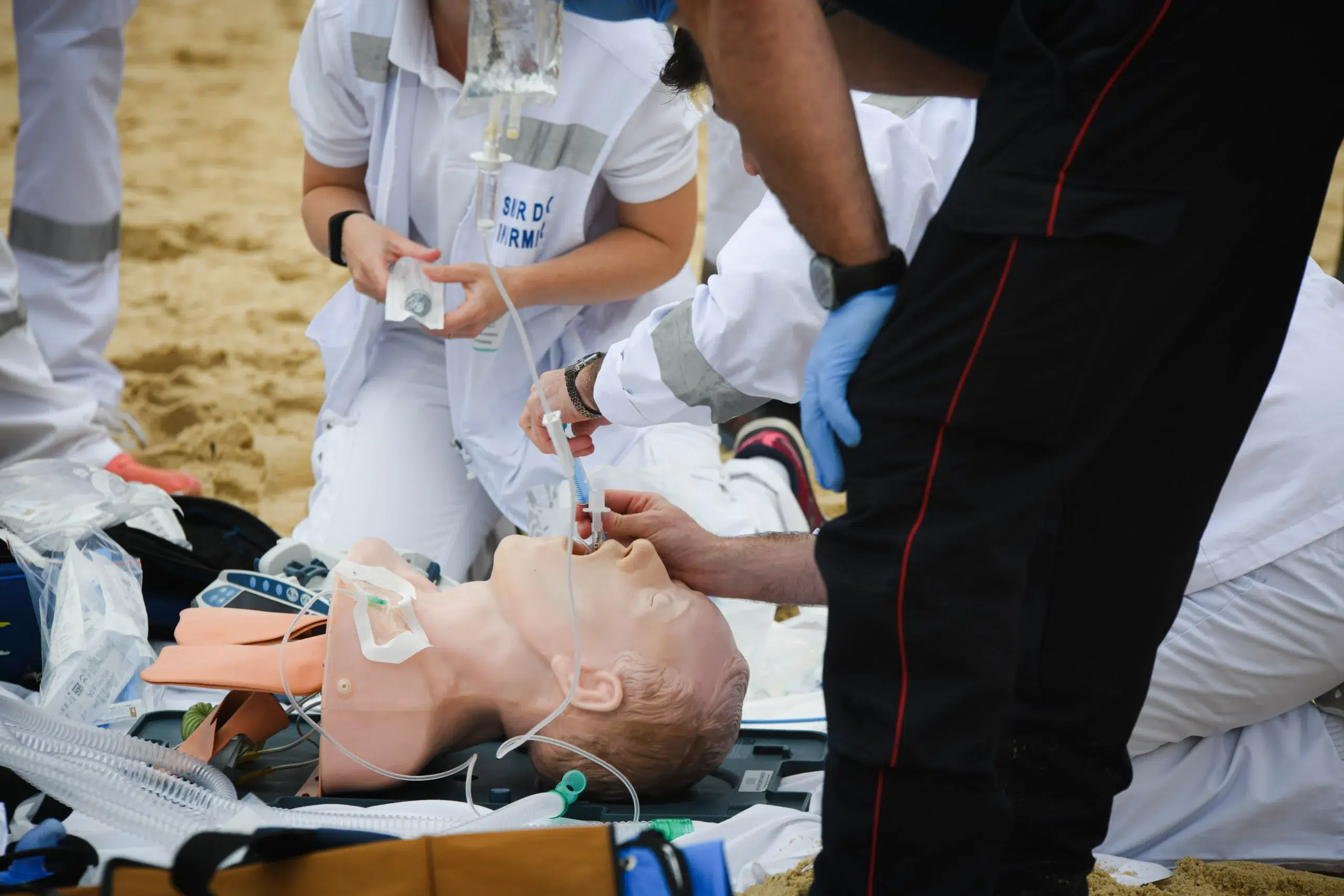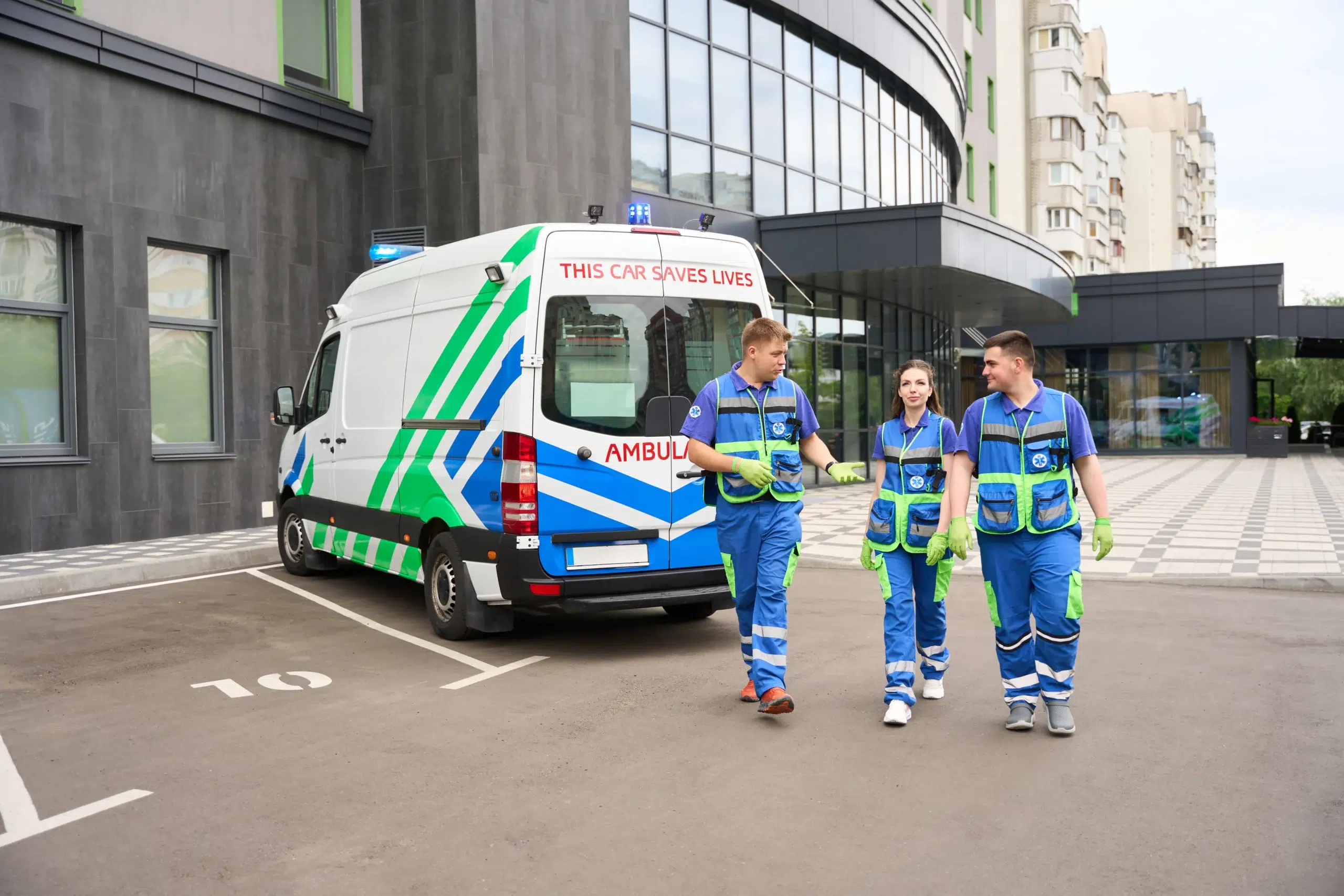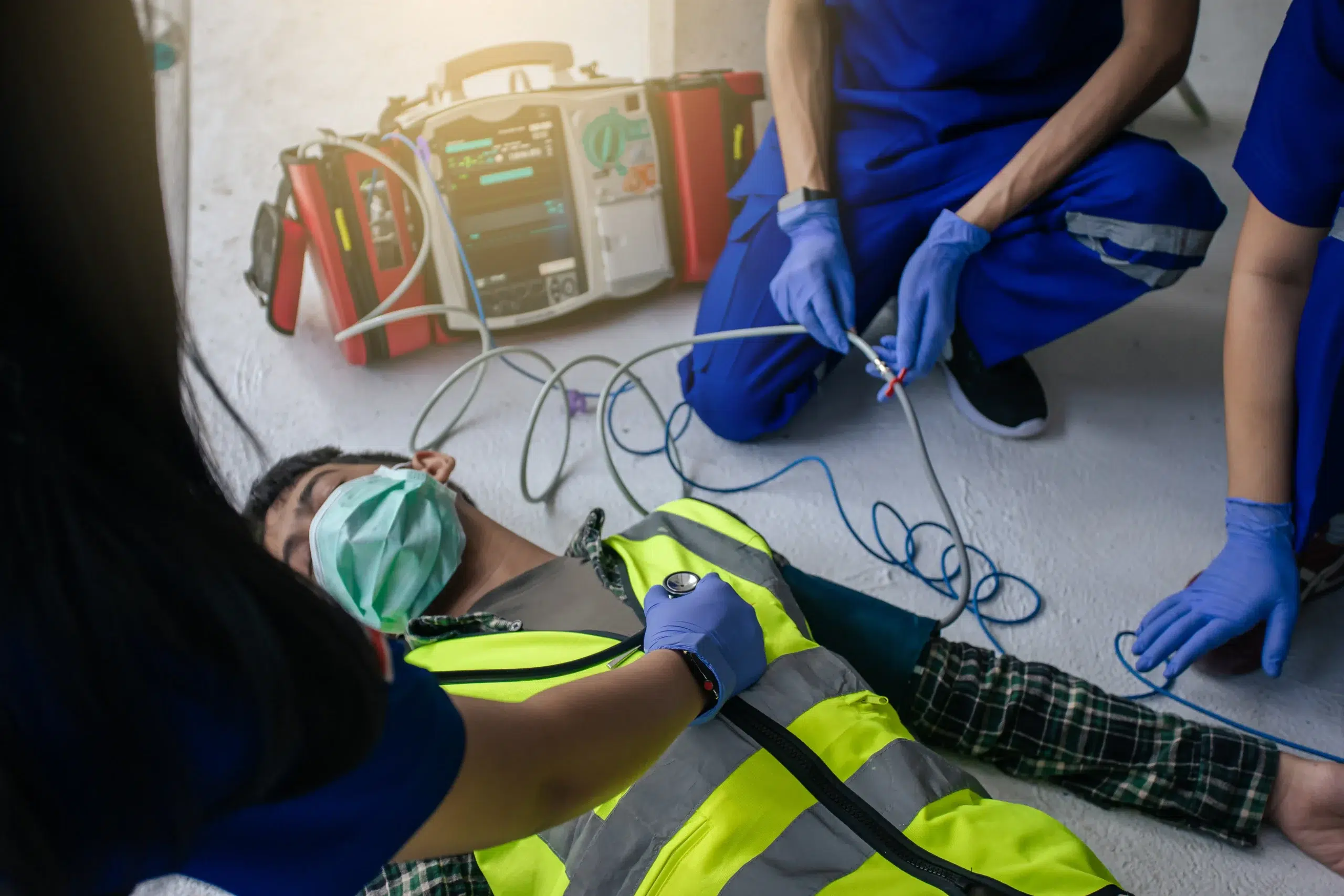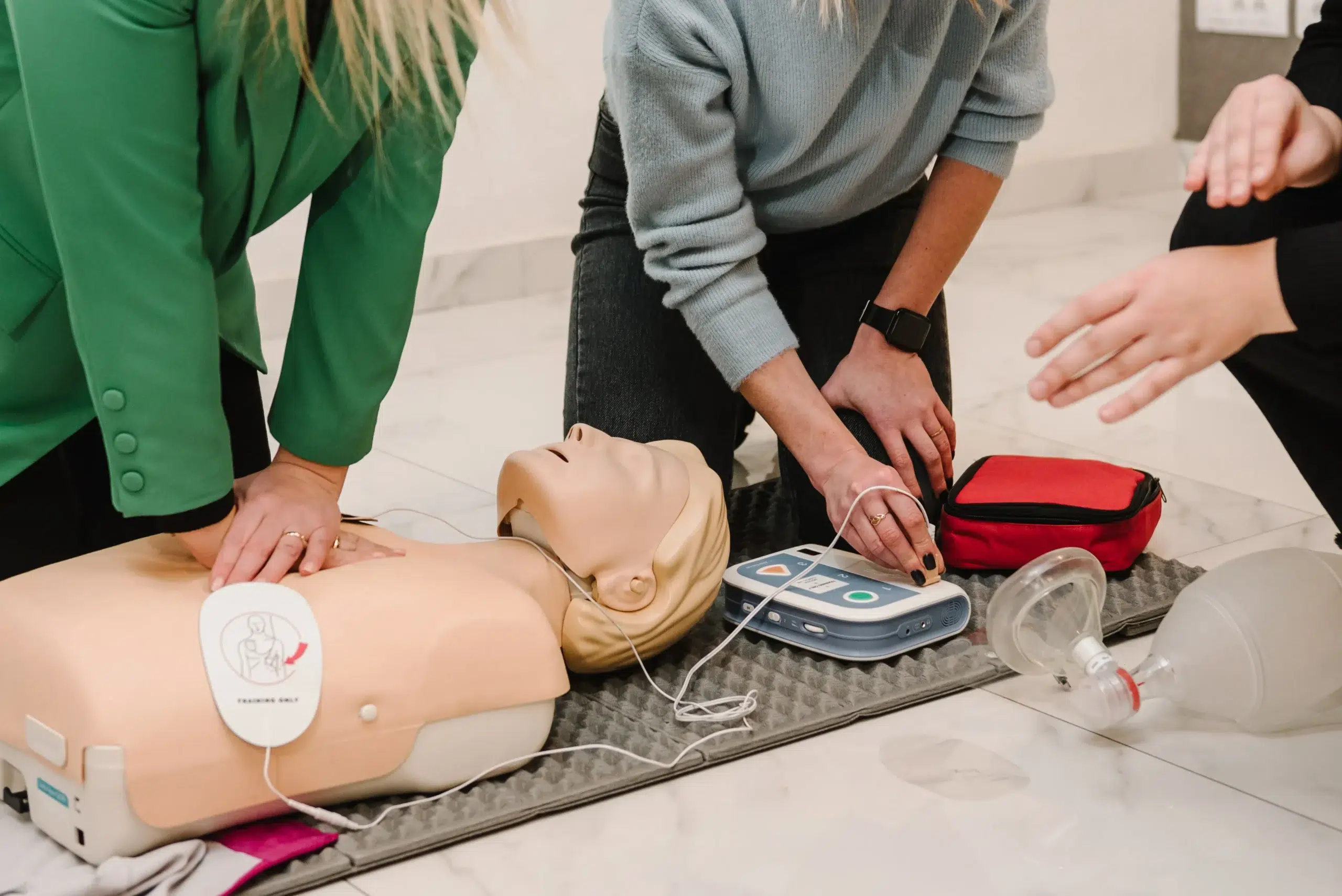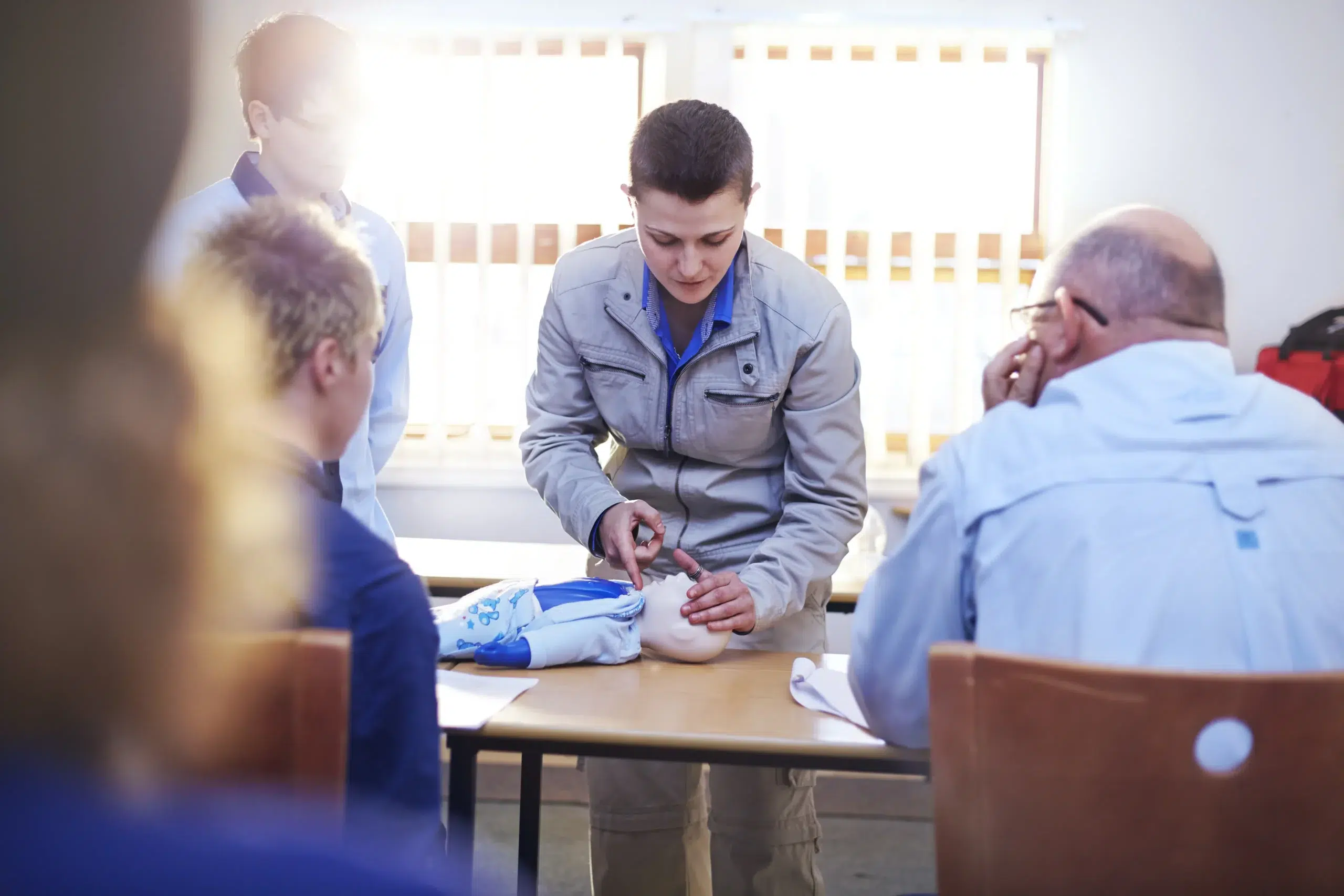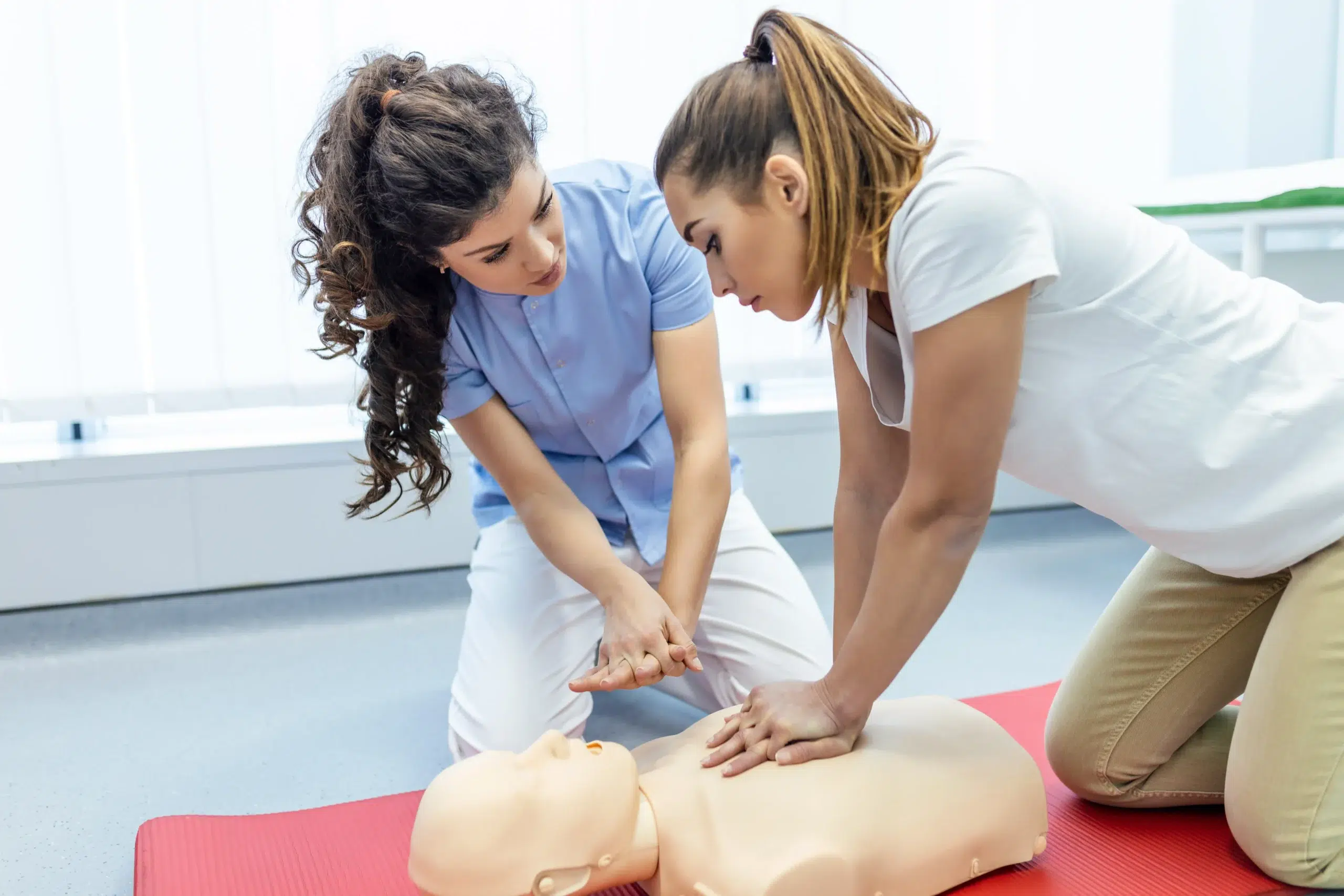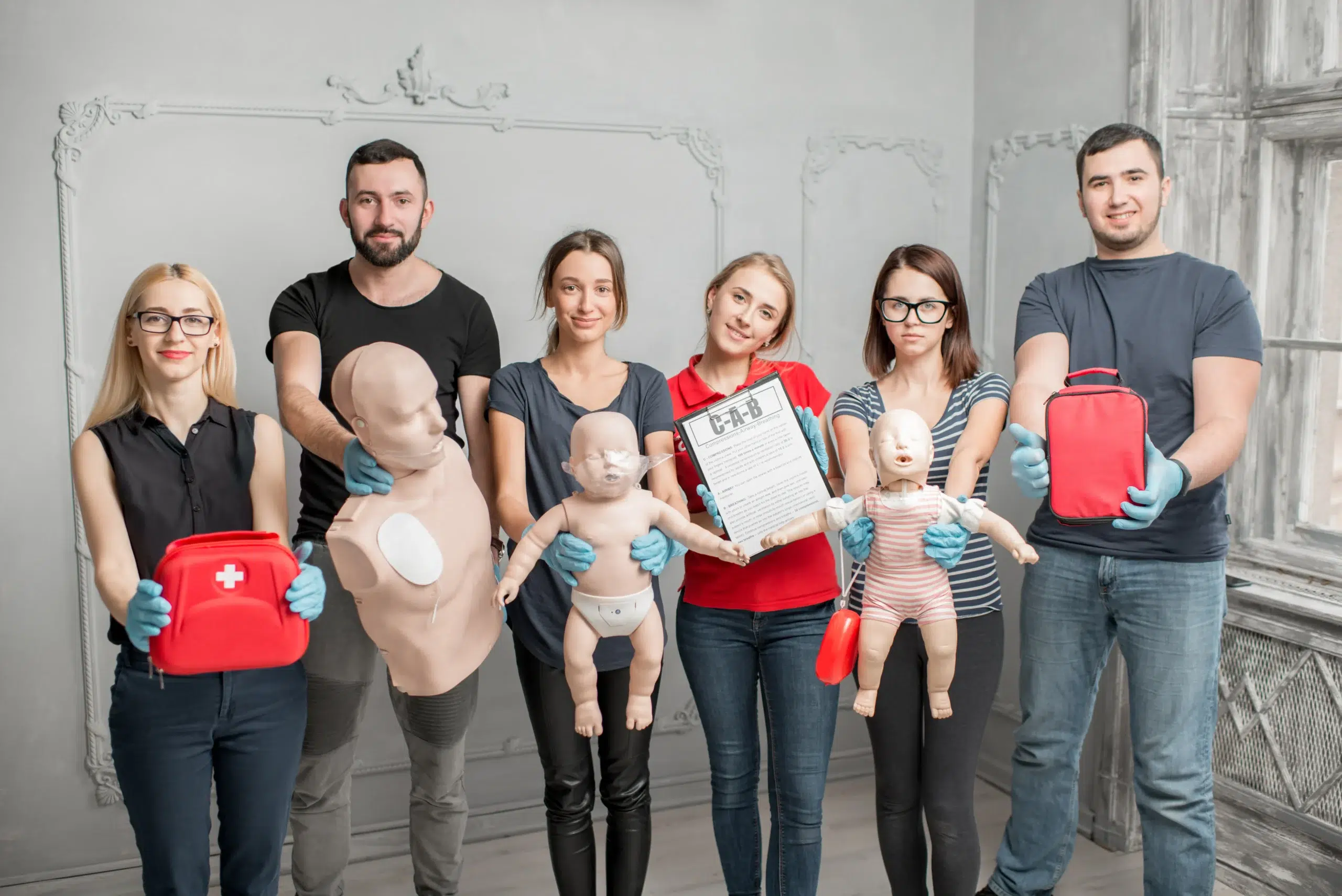Emergencies can happen anytime, anywhere. Are you prepared to respond? BLS certification equips you with the skills to provide immediate care in life-threatening situations. This comprehensive guide covers everything you need to know about BLS certification, from the core skills and training formats to finding a “BLS certification near me.” We’ll also address common misconceptions about BLS, discuss the cost of certification, and offer valuable tips for effective learning. Whether you’re a healthcare provider, a caregiver, or simply someone who wants to be prepared, this guide will help you understand the importance of BLS and how to get certified.
Key Takeaways
- BLS skills empower anyone: From healthcare professionals to everyday individuals, BLS training provides the confidence to respond effectively in emergencies. Find a course that suits your needs and learn these vital skills.
- Select a reputable BLS provider: Accreditation, instructor experience, and comprehensive materials are key factors when choosing a BLS course. Pleasant Hill CPR Classes offers AHA-certified training.
- Stay current with BLS: Maintain your certification and keep your skills sharp by renewing every two years. Regularly review updated guidelines to ensure you’re providing the most effective care.
What is BLS Certification & Why is it Important?
BLS certification equips you with the skills to respond to life-threatening emergencies. It’s a critical credential, especially in healthcare, focusing on immediate intervention and stabilization techniques. BLS goes beyond basic first aid, covering core life-saving procedures like CPR, using an AED, and relieving choking. This certification isn’t just for healthcare providers—it’s a valuable asset for anyone who wants to be prepared to help in a crisis. Knowing BLS can make a real difference, empowering you to confidently provide support until professional medical help arrives.
Core BLS Skills
A BLS course blends theory and hands-on practice to get you ready for real-world emergencies. You’ll learn how to use an AED, essential techniques for airway management, and how to help someone who’s choking. These skills are the foundation of effective emergency response, giving you the confidence to act quickly and decisively when every second counts. BLS training emphasizes high-quality CPR and coordinated teamwork, vital for improving patient outcomes. The goal is to build muscle memory and quick thinking through repetitive practice, ensuring you can perform these skills effectively under pressure.
Who Needs BLS Certification?
BLS certification is essential for a wide range of healthcare professionals, from doctors and nurses to paramedics and EMTs. It’s a requirement for many healthcare roles and often a prerequisite for advanced certifications like ACLS (Advanced Cardiovascular Life Support) and PALS (Pediatric Advanced Life Support). But the value of BLS extends beyond the medical field. Anyone working in childcare, education, fitness, or even just concerned individuals can benefit from having these life-saving skills. Think lifeguards, teachers, coaches, personal trainers—anyone who might encounter a medical emergency. Getting your BLS certification is an investment in your ability to help others and make a difference in critical situations. It’s about being prepared, being confident, and having the skills to potentially save a life.
Find BLS Certification Courses Near You
Finding the right BLS certification course often starts with a simple “BLS certification near me” search. But with so many options, it’s helpful to understand the different types of providers and what they offer. Here’s a breakdown:
Pleasant Hill CPR Classes
Pleasant Hill CPR Classes offers a range of American Heart Association courses, including BLS certification. They focus on providing convenient and affordable options for those in the Pleasant Hill, Walnut Creek, and Concord, CA areas. Their low price guarantee makes them a budget-friendly choice. They also specialize in RQI programs, a great option for busy medical professionals seeking an efficient way to maintain their certification. Learn more about their RQI classes and other offerings on their website. For any questions, feel free to contact them directly.
American Red Cross
The American Red Cross is a well-known provider of BLS certification courses nationwide. They offer classes designed for healthcare providers and other professionals needing BLS skills. You can easily find a Red Cross BLS course near you by visiting their website. Their established curriculum and widespread availability make them a solid option.
Local Hospitals & Healthcare Centers
Many hospitals and healthcare centers offer BLS certification courses, often open to the public. These courses are typically taught by experienced medical professionals and offer a practical, hands-on learning environment. Contact your local hospitals or check their websites for information on their programs.
Community Colleges
Community colleges frequently offer BLS certification within their healthcare and continuing education programs. These courses are often more affordable than private training centers and can be a great option for students and those entering the healthcare field. Check with your local community college for details.
How Much Does BLS Certification Cost?
One of the most common questions about BLS certification is the cost. It’s an important factor when choosing a course, but the price can vary. Let’s break down the typical price range and explore ways to make training more affordable.
Average Price Range
BLS certification courses typically range from $70 to $100. The price often depends on the certifying organization (like the American Heart Association) and whether you’re taking a new certification course or renewing an existing one. Renewal courses are sometimes offered at a slightly lower price. For the most up-to-date pricing on our BLS courses at Pleasant Hill CPR Classes, contact us. Also, check our low price guarantee.
Group Discounts & Financial Aid
If you’re training with a group, like coworkers or a community organization, ask about group discounts. Many providers, including Pleasant Hill CPR Classes, offer reduced rates for group bookings. While financial aid specifically for BLS certification isn’t always available, some employers may cover the cost of training, especially for healthcare professionals. Check with your employer’s HR department. Some professional organizations offer scholarships or grants that could help offset the cost of professional development courses like BLS certification.
Choose the Right BLS Training Format
Finding the right BLS training format depends on your learning style, schedule, and budget. Let’s explore the most common options: in-person, online, and blended learning. Each has its own advantages, so consider what works best for you.
In-Person Classes
In-person BLS classes offer a hands-on learning experience. You’ll practice skills like CPR and using an AED in a controlled setting, with direct guidance from a certified instructor. This format allows for immediate feedback and personalized instruction, which can be invaluable for mastering these critical skills. Pleasant Hill CPR Classes offers in-person BLS training right here in the East Bay, providing a convenient option for local residents. The interactive nature of in-person training can also help build confidence among participants.
Online Courses
Online BLS courses provide flexibility and convenience. You can learn at your own pace, fitting the training around your busy schedule and completing the coursework from anywhere with an internet connection. This format often involves interactive modules, videos, and quizzes to reinforce learning. The online BLS certification from the American Red Cross is a good example of this approach. While online courses excel in delivering theoretical knowledge, they typically require a separate in-person skills session for hands-on practice and official certification.
Blended Learning
Blended learning combines the best of both worlds. You’ll cover the theoretical material online at your own speed, then attend an in-person skills session to practice and demonstrate your proficiency. This approach offers the convenience of online learning with the essential hands-on training component. The Red Cross also offers a blended learning option for BLS certification, allowing you to tailor your learning experience. This format can be particularly helpful for those who prefer to absorb information independently but still value the guidance of an instructor for practical application.
What to Expect in a BLS Course
Getting ready for a BLS course? Here’s a rundown of what you’ll learn, how long the course takes, and how you’ll practice your skills. Knowing what to expect can help you feel prepared and confident on training day.
Course Content & Structure
BLS courses cover the core skills needed to respond to life-threatening emergencies. You’ll learn adult, child, and infant CPR, along with how to relieve choking. The curriculum also includes training on using an Automated External Defibrillator (AED) and providing basic first aid. Many courses also cover topics like scene safety, teamwork, communication, and the legal aspects of providing first aid. This comprehensive approach ensures you’re well-equipped to handle various emergency situations. For a closer look at what’s involved, check out the American Heart Association BLS course details.
Duration & Time Commitment
BLS certification is typically valid for two years. Renewal courses are available if your certification is about to expire. The time commitment for initial certification varies, but most courses involve a combination of online learning and in-person skills practice. This blended learning approach allows you to study the material at your own pace before demonstrating your skills in a hands-on setting. Check out our RQI classes for a streamlined and efficient certification process.
Hands-On Practice & Assessment
BLS courses emphasize hands-on learning to build confidence and proficiency. After completing the online portion, you’ll participate in in-person sessions with a certified instructor. These sessions provide opportunities to practice your skills on mannequins and with other students, allowing you to refine your technique in a supportive environment. You’ll receive feedback from your instructor and have the chance to ask questions, ensuring you’re fully prepared to apply your knowledge in real-world scenarios. Some institutions utilize RQI Skills Stations for hands-on practice, offering a structured and efficient way to master essential BLS skills. Contact us to learn more about our low price guarantee and flexible class options. We’re here to help you find the best fit for your schedule and budget. Reach out today!
Prepare for Your BLS Certification
Getting ready for your BLS certification involves more than just showing up for class. A little prep work goes a long way in building your confidence and preparing you for learning. This section covers how to study effectively and offers some helpful resources.
Study Resources & Practice Tests
Before your BLS certification course, take some time to familiarize yourself with the basics. Many providers, like Pleasant Hill CPR Classes, offer study guides and practice tests to help you get comfortable with the material. Even a quick review of key terms and concepts can make a big difference in how well you absorb information during the course. Think of it as a warm-up before the main event. Some providers also offer practice quizzes, a great way to test your knowledge and pinpoint areas where you might need extra focus.
Tips for Effective Learning
Want to maximize your study time? Start with the key terms. Once you have those down, move on to practicing the actual skills. Hands-on practice is key for mastering BLS techniques. Find a friend or family member to practice with, or use a manikin if you have one. Regular practice not only helps you prepare for the certification exam, but also builds the muscle memory you’ll need in a real-life emergency. Finally, create a distraction-free study space. Minimize distractions to stay focused and absorb the material effectively. Turn off your phone, find a quiet room, and let your family know you need uninterrupted time. A focused study session is always more productive.
Maintain Your BLS Certification
Once you’ve earned your BLS certification, maintaining it is key to ensuring you’re always prepared to provide effective, high-quality care. Staying current with the latest guidelines demonstrates your commitment to best practices and helps you confidently respond to emergencies.
Renewal Process
BLS certification is typically valid for two years. It’s essential to keep track of your expiration date and plan for renewal accordingly. Pleasant Hill CPR Classes offers BLS renewal courses to help you seamlessly maintain your credentials. Renewal courses are generally shorter than initial certification courses, focusing on refreshing your knowledge and skills. Start the renewal process about a month before your certification expires to find a class that fits your schedule and avoid a lapse in certification.
Stay Updated on Guidelines
The medical field is constantly evolving, and BLS guidelines are updated periodically to reflect the latest scientific evidence and best practices. Staying informed about these updates is crucial for providing the most effective care. Organizations like the American Heart Association and the Red Cross regularly review and update their BLS training materials. Familiarize yourself with the current guidelines and incorporate them into your practice. Engaging with updated training materials and participating in continuing education will help you stay at the forefront of BLS knowledge and skills. This commitment to ongoing learning benefits your professional development and ensures you’re prepared to deliver the highest standard of care in any emergency.
Choose the Best BLS Provider
Finding the right BLS provider is just as important as the certification itself. Here’s what to look for:
Accreditation & Recognition
A reputable BLS provider should be accredited by a recognized organization like the American Heart Association (AHA). The AHA sets the standards for high-quality BLS training, so choosing an AHA-affiliated provider like Pleasant Hill CPR Classes ensures your training aligns with nationally accepted guidelines. This is crucial for both your credibility and the quality of care you can provide. Pleasant Hill CPR Classes offers a range of AHA-certified courses, from BLS for healthcare providers to specialized programs like RQI.
Instructor Qualifications
Experienced instructors are key to effective BLS training. Look for providers with instructors who have both extensive certifications and real-world experience. Instructors should be able to clearly explain concepts, demonstrate techniques, and provide constructive feedback. A knowledgeable instructor can make all the difference in your confidence and competence. Contact Pleasant Hill CPR Classes to learn more about our instructors’ qualifications.
Course Materials & Resources
Comprehensive course materials are essential for successful learning. Your BLS course should cover core skills like CPR, AED use, and airway management. High-quality resources, including up-to-date manuals and practice equipment, can significantly enhance your learning experience. Pleasant Hill CPR Classes provides all the necessary materials and resources to help you succeed, and we offer a low price guarantee.
Common BLS Misconceptions
Debunking Myths
There’s a lot of misinformation floating around about BLS certification. Let’s clear up some common myths and set the record straight. Because when it comes to lifesaving skills, accurate information is key.
Myth #1: BLS Certification is Only for Doctors and Nurses.
Nope, not true! While BLS is essential for healthcare providers, it’s valuable for anyone who might find themselves in an emergency situation. Think first responders, teachers, coaches, lifeguards, and even parents. Having BLS training can empower you to act confidently and potentially save a life, no matter your profession. Check out our BLS course to learn more.
Myth #2: BLS Certification is Too Time-Consuming.
I get it, we’re all busy. But BLS certification doesn’t have to take over your life. Many providers, including Pleasant Hill CPR Classes, offer streamlined courses designed to fit your schedule. You can often become certified in just a few hours.
Myth #3: BLS Certification is Not Necessary if You Have CPR Training.
CPR is a fantastic skill to have, absolutely. But BLS certification goes beyond basic CPR. It covers a wider range of life-saving techniques, like using an AED and managing airways. These extra skills can make a critical difference in an emergency. If you’re serious about being prepared, BLS certification is the way to go. It builds on your CPR knowledge and equips you with more tools to handle various situations. This article further explains the differences between CPR and BLS.
Myth #4: Online BLS Certification is Not as Credible as In-Person Training.
This one’s a bit outdated. Reputable organizations now offer accredited online BLS courses that are just as valid as in-person training. These courses often include interactive elements and simulations to ensure you’re absorbing the information and developing the necessary skills. Learn more about the different training formats available.
Myth #5: BLS Certification is a One-Time Requirement.
Think of BLS certification like a driver’s license—it needs to be renewed. Medical guidelines and best practices are constantly evolving, so renewing your BLS certification every two years ensures your knowledge is current and you’re prepared to provide the most effective care. It’s a simple step to stay on top of your lifesaving skills.
BLS Certification for Career Advancement
For many healthcare professionals, BLS certification isn’t just a bonus—it’s a requirement and a fundamental stepping stone in your medical career. It demonstrates your commitment to patient safety and high-quality care. Whether you’re just starting out or looking to advance, understanding the role of BLS certification can significantly impact your career trajectory.
Healthcare Professions that Require BLS
BLS certification is often mandatory for a wide range of healthcare roles. These include physicians, nurses, paramedics, emergency medical technicians (EMTs), physician assistants, dental assistants, medical assistants, and pharmacists. Essentially, anyone working directly with patients in a healthcare setting will likely need this essential certification. Even if not explicitly required for your specific role, having a BLS certification can make you a more competitive candidate and open doors to new opportunities. It shows potential employers you’re prepared to handle emergencies and prioritize patient well-being.
Impact on Patient Care & Safety
BLS certification equips healthcare providers with the skills to respond effectively in critical situations, from recognizing the signs of a cardiac arrest to performing CPR and using an AED. These skills are crucial for positive patient outcomes. The ability to provide immediate and appropriate care can significantly improve a patient’s chances of survival and recovery. BLS training also emphasizes teamwork and communication, vital in high-pressure medical environments. A well-coordinated team response can minimize errors and ensure the best possible care for patients. By maintaining your BLS certification, you contribute to a culture of safety and preparedness within your healthcare setting, ultimately leading to better patient care.
Related Articles
- BLS Training Near Me: Your Complete Guide – Pleasant Hill CPR Classes
- BLS Courses Pleasant Hill: Your Certification Guide – Pleasant Hill CPR Classes
- BLS Certification in Concord: Courses & Providers – Pleasant Hill CPR Classes
- BLS Recertification Near Me: Your Complete Guide – Pleasant Hill CPR Classes
- BLS Renewal Near Me: A Complete Guide – Pleasant Hill CPR Classes
Frequently Asked Questions
Is BLS certification only for healthcare professionals? While BLS is a core requirement for many healthcare roles, it’s a valuable skill for anyone to have. From teachers and coaches to parents and caregivers, BLS training empowers individuals to respond effectively in emergencies. It’s about being prepared to help, regardless of your profession.
What’s the difference between BLS and CPR certification? CPR is one component of BLS. BLS certification encompasses a broader range of skills, including CPR, AED use, and airway management techniques. It provides a more comprehensive approach to emergency response.
How long does it take to get BLS certified? BLS certification courses vary in length, but many can be completed in a single day. Some providers offer blended learning options, allowing you to study the theoretical material online at your own pace before attending a shorter in-person skills session.
How much does BLS certification cost, and are there any discounts available? The cost of BLS certification varies depending on the training provider and location. Many providers offer group discounts, so if you’re training with colleagues or friends, it’s worth inquiring about reduced rates. Some employers also cover the cost of BLS training for their employees.
How often do I need to renew my BLS certification? BLS certification is typically valid for two years. Staying current with the latest guidelines and best practices is essential for providing effective care, so renewing your certification on time is crucial.
